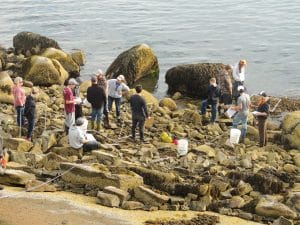Deer Isle-Stonington High School: Takeaways and Burning Questions
CompetencyWorks Blog

This post is part of the series Road Trip to Maine. This is the last of a three-part look at Deer Isle-Stonington High School. Start with the first post on Turning Around the Culture and the second post on Breathing Life into the Standards.
The conversation with Todd West, principal of Deer Isle-Stonington High School left me with a number of questions and new insights, some of which I’m still noodling on.
- It’s-About-Every-Student Leadership: We all know that leadership is an important aspect of any endeavor, and we can often get lost in the leadership style, the charisma, the vision. However, in proficiency-based learning, it always starts with values and commitment. You can tell what Todd West’s leadership is when he asks, “Why can’t we consistently have a high graduation rate? We have fifty teachers in our district, can’t we figure out how to get those two, three, four, or five kids who are having a tough time to the finish line?” This is the mindset of continuous improvement. This is the mindset that needs to replace the compliance mindset of a 100-year old education system.
- Community Development as Motivation and Context: I’ve only come across a few schools that take into consideration community need or community development in the construction of their design. In addition to DISHS, ACE Leadership in Albuquerque and Belfry High School in Pike County in Kentucky (hard hit by the changes in the coal industry) have designed projects rooted in community development. As we think about student-centered learning, it may be important to listen for when student passion is about trying to get a grip on the huge forces shaping the lives of their siblings, cousins, parents, and grandparents. I can’t help but wonder – are we possibly creating a virtuous cycle that can expand well beyond the school walls as we embrace empowerment, agency, and a growth mindset?
- Calibration in a Rural Community: If you are working in the only high school and there are only one or two people in a department, how do you know if your understanding of proficiency is really going to be aligned with colleges? If teachers have worked in the same school for decades, how are they going to know what student work should look like to be considered proficient, especially with higher order skills? New Hampshire’s PACE is calibrating performance assessment across districts. Will we need to do that with every district, every school, every teacher, or can technology help expedite the process? The Illuminating Standards project provides exemplars of writing at different academic levels. Perhaps digital resources would help us through this challenge. It’s a start.
- Does it Really Make Sense to Use NWEA Assessments in High School? DISHS uses NWEA MAP to test incoming students and, throughout high school, to measure growth. After West and I walked through his data, I started doubting that it can be very helpful except for students still building their foundational skills. Throughout the years, I’ve had a number of people tell me that after tenth grade, it doesn’t offer much in terms of insight of student growth. How is it capturing the higher order skills? How is it able to monitor students’ ability to analyze problems through multiple lenses or to solve complex problems? And the biggest problem is that it doesn’t seem to be able to capture growth in the high school years. They say it does, but I’m really questioning it.
There is more to come from my Maine road trip. Stay tuned!
See also: